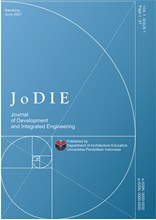The Philosophy of National Monument (Monas) in Jakarta, Indonesia
Abstract
Full Text:
PDFReferences
Fandra, Muhammad. 2022. “Monumen Nasional Sebagai Ide Penciptaan Dhapur Tombak.” Ornamen 18(2):101–9. doi: 10.33153/ornamen.v18i2.3700.
Hantono, Dedi, Yuanita F. D. Sidabutar, and Ully I. M. Hanafiah. 2018. “Kajian Ruang Publik Kota Antara Aktivitas Dan Keterbatasan.” Langkau Betang: Jurnal Arsitektur 5(2):80. doi: 10.26418/lantang.v5i2.29387.
Kane, Shashank N., Ashutosh Mishra, and Anup K. Dutta. 2016. “Preface: International Conference on Recent Trends in Physics (ICRTP 2016).” Journal of Physics: Conference Series 755(1):1–8. doi: 10.1088/1742-6596/755/1/011001.
Kanumoyoso, Bondan. 2020. “Membentuk Karakter Bangsa: Sejarah Indonesia Dalam Diorama Monumen Nasional.” Walasuji : Jurnal Sejarah Dan Budaya 7(1):1–16. doi: 10.36869/wjsb.v7i1.83.
Mirwa, Tetty, Sugito Sugito, Khaerul Saleh, and Nelson Tarigan. 2023. “Karakteristik Patung Monumen Dan Tugu Di Kota Medan.” Gorga : Jurnal Seni Rupa 12(1):33. doi: 10.24114/gr.v12i1.38907.
Purnamasari, Ria, Wawan Septiawan, and Dedi Hantono. 2022. “Respon Masyarakat Terhadap Dampak Revitalisasi Kawasan Monumen Nasional Bagi Lingkungan Sekitar.” Jurnal Potensi 2(2):1–12.
Rachmadi, Gustiyan, Husen Hendriyana, and Asep Miftahul Falah. 2023. “Kontekstualitas Dan Representasional Patung Monumen Di Kota Bandung.” Panggung 33(2):155–71. doi: 10.26742/panggung.v33i2.2609.
Sartika, Kiki Ardilah, and Kabib Sholeh. 2024. “Monumen Perjuangan Rakyat (Monpera) Dalam Memori Kolektif Masyarakat Kota Palembang Tahun 1945- 1947.” CARITA: Jurnal Sejarah Dan Budaya 2(2):119–34. doi: 10.35905/carita.v2i2.8683.
Sumarandak, Marco E. N., Aristotulus E. Tungka, and Pingkan Peggy Egam. 2021. “Persepsi Masyarakat Terhadap Kawasan Monumen Di Manado.” Jurnal Spasial 8(2):255–68.
Susilo, Susilo, and Angelia Rantya Apriliawati Suryaningsih. 2015. “Monas Sebagai Simbol Perjuangan Bangsa Indonesia.” Kepariwisataan: Jurnal Ilmiah 9(03):55–78. doi: 10.47256/kepariwisataan.v9i03.139.
DOI: https://doi.org/10.17509/jodie.v4i2.76798
Refbacks
- There are currently no refbacks.
Copyright (c) 2025 Khalid Farah Hersi

This work is licensed under a Creative Commons Attribution-NonCommercial-ShareAlike 4.0 International License.

This work is licensed under a Creative Commons Attribution-ShareAlike 4.0 International License.








